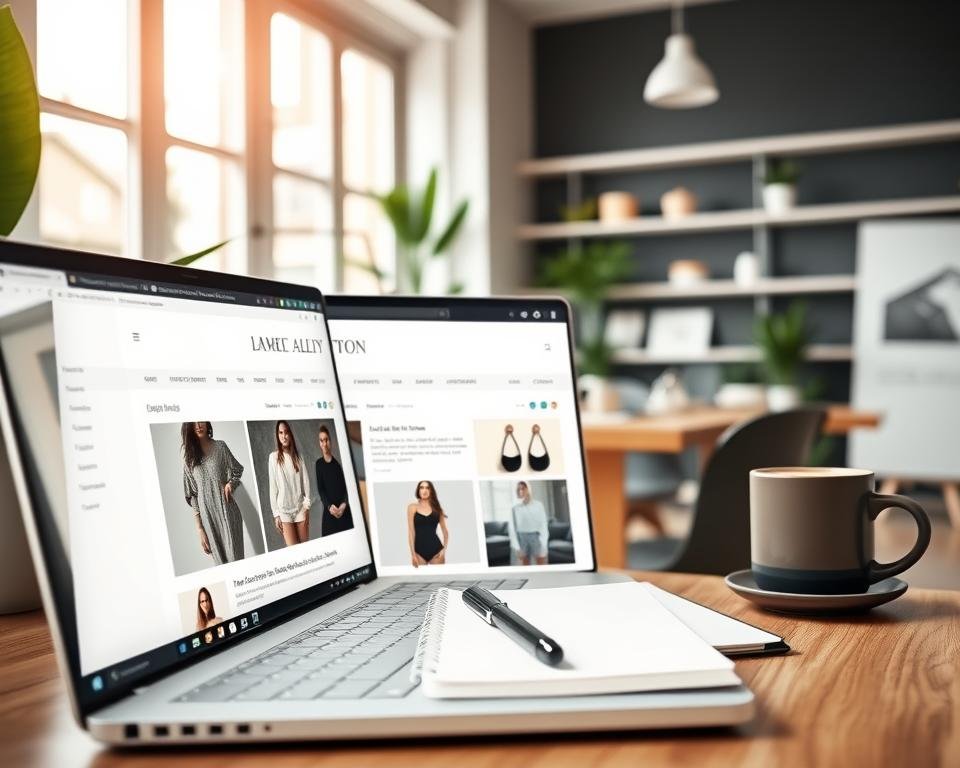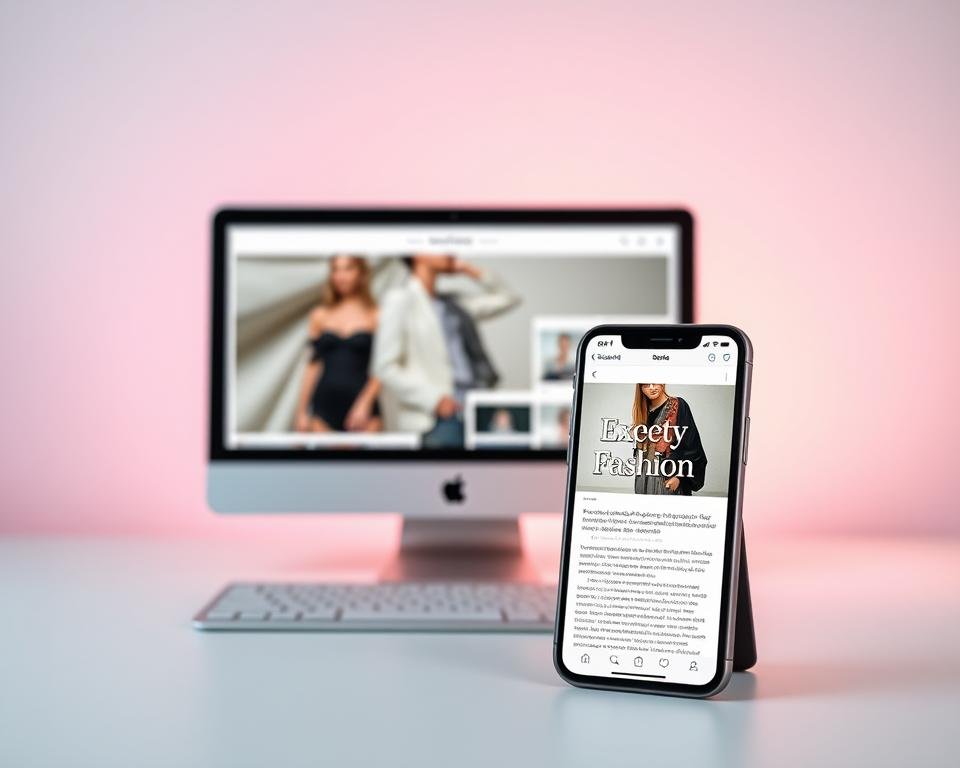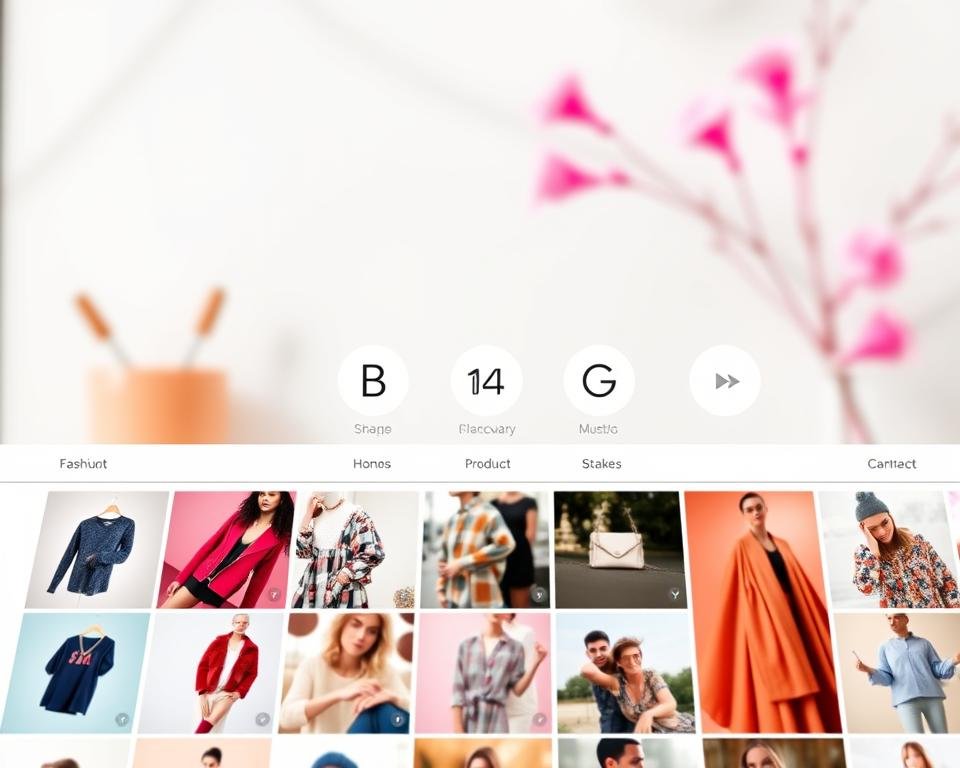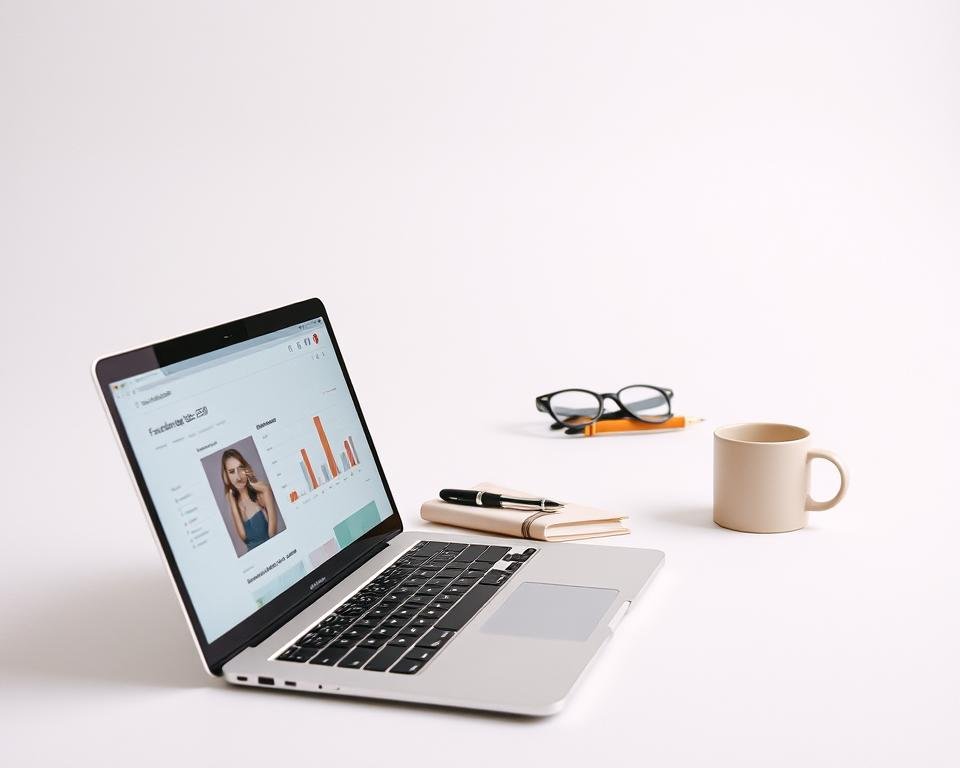Starting a fashion blog? Knowing how to use SEO strategy is key to success online.
I’ll show you how to make a fashion blog SEO plan. You’ll learn the basics and how to use them on your site.
By the end, you’ll know how to make your site search engine friendly. This will help you get more visitors and grow your online presence.
Key Takeaways
- Understanding the basics of SEO strategy
- Applying fundamental SEO concepts to your fashion blog
- Increasing online visibility
- Driving more traffic to your site
- Optimizing your site for search engines
Understanding SEO Basics for Fashion Blogs
Knowing the basics of SEO is key for fashion bloggers wanting to grow online. We’ll explore SEO basics and why they’re important for your blog’s success.
What is SEO?
SEO means Search Engine Optimization. It’s about making your website better for search engines like Google. This way, your site can show up higher in search results.
A good SEO plan helps you understand search engines and what people look for. It makes your content more useful to your readers.
Importance of SEO in Fashion Blogging
For fashion bloggers, SEO is vital. It can help you get more visitors and make more money. By optimizing your blog, you can become more visible and credible online.
| Metric | Without SEO | With SEO |
|---|---|---|
| Website Traffic | 100 visitors/month | 1,000 visitors/month |
| Search Engine Ranking | Page 5+ | Page 1 |
| Revenue | Limited | High |
As the table shows, using SEO can greatly improve your blog’s online presence. It opens up new chances for growth.
Keyword Research: The Foundation of Your Strategy
To make content that people like and search engines rank high, start with keyword research. It’s key to any good SEO plan. It shows what your audience looks for online.
Finding the right keywords helps your blog posts match what people search for. This makes your site more visible and brings in more relevant visitors.
Tools for Keyword Research
Many tools help with keyword research, each with special features. Some top ones are:
- Google Keyword Planner: A free tool for finding keywords and their search volume.
- Ahrefs: Offers detailed keyword research, including looking at competitors and finding content gaps.
- SEMrush: Does technical SEO checks, keyword research, and competitor analysis.
Using these tools well can find great keywords your audience wants. For example, Google Keyword Planner can suggest keywords. Then, Ahrefs or SEMrush can check their competition and search volume.
| Tool | Key Features | Cost |
|---|---|---|
| Google Keyword Planner | Keyword suggestions, search volume estimates | Free |
| Ahrefs | Comprehensive keyword database, competitor analysis | Paid |
| SEMrush | Technical SEO audits, keyword research, competitor analysis | Paid |
Long-tail vs. Short-tail Keywords
Knowing the difference between long-tail and short-tail keywords is key. Short-tail keywords are short and general, like one or two words. They get a lot of searches but are very competitive.
Long-tail keywords are longer and more specific, with fewer searches. They’re less competitive and target specific searches. For example, “fashion trends” is short-tail, while “summer fashion trends for women over 30” is long-tail.

Going for long-tail keywords can bring more relevant visitors to your blog. It’s a slow but rewarding strategy.
On-Page SEO Techniques for Fashion Bloggers
To stand out in the competitive world of fashion blogging, it’s key to know and use effective on-page SEO strategies. On-page SEO means making your web pages better to rank higher and get more relevant traffic. For fashion bloggers, this includes several key techniques to boost your blog’s visibility in search engine results.
Crafting SEO-Friendly Titles
The title of your blog post is very important for on-page SEO. It should be both informative and appealing to search engines. Here are some tips for crafting SEO-friendly titles:
- Include your primary keyword near the beginning of the title.
- Keep your title concise, ideally under 60 characters.
- Make sure your title accurately reflects the content of your blog post.
Example of an SEO-Friendly Title: “Summer Fashion Trends: Top 10 Must-Have Pieces for Your Wardrobe”
Optimizing Meta Descriptions
Meta descriptions give a summary of your blog post and are key to getting users to click through to your site. Here are some best practices for optimizing meta descriptions:
- Keep your meta description under 160 characters.
- Include your primary keyword to improve relevance.
- Craft a compelling description that encourages click-throughs.
Example of an Optimized Meta Description: “Discover the latest summer fashion trends and must-have pieces for your wardrobe. Get the inside scoop on the top fashion styles of the season.”
| SEO Element | Best Practice | Example |
|---|---|---|
| Title | Include primary keyword, under 60 characters | Summer Fashion Trends |
| Meta Description | Under 160 characters, include primary keyword | Discover the latest summer fashion trends… |

By mastering these on-page SEO techniques, you can make your fashion blog more visible in search engine results. This will drive more traffic to your site and boost your online presence.
Creating High-Quality Content That Ranks
Creating content that your audience loves and ranks well is key for fashion bloggers. It’s important to know what makes content great and SEO-friendly.
Understanding User Intent
User intent is why someone searches for something. Knowing this is key to making content that meets their needs. For fashion bloggers, it’s about knowing if people want product reviews, styling tips, or trend forecasts.
To match user intent, I make content that’s informative and relevant. I use keywords wisely and give insights that answer the user’s question.
Key considerations for understanding user intent include:
- Identifying the primary purpose of the user’s search query
- Analyzing the type of content currently ranking for the target keywords
- Determining the level of detail and expertise required to satisfy the user’s query
How to Use Visuals Effectively
Visuals make content more engaging and user-friendly. For fashion bloggers, using high-quality images, videos, or infographics can make their content stand out.
It’s important to make sure visuals are relevant, high-quality, and fast-loading. I also use alt tags and descriptive text for better accessibility and SEO.

A well-structured table can organize complex information clearly. Here’s how different visuals can be used well in a fashion blog:
| Type of Visual | Purpose | SEO Benefit |
|---|---|---|
| High-quality Images | Showcase products or styles | Improved user engagement and page dwell time |
| Infographics | Present statistical data or trends | Enhanced shareability and backlink opportunity |
| Videos | Provide tutorials or product reviews | Increased content diversity and lower bounce rates |
By understanding user intent and using visuals well, fashion bloggers can make content that engages their audience and ranks well in search engines.
Building a Mobile-Friendly Fashion Blog
More people use mobile devices every day. For fashion bloggers, having a mobile-friendly blog is a must. It makes sure your content works well on any device.
Why Mobile Optimization Matters
Mobile optimization is key for a good user experience. A mobile-friendly blog loads fast and is easy to use. It looks great on small screens too.
This makes users happy and helps your blog rank better on search engines. Google likes websites that work well on phones.
A mobile-friendly blog is essential for fashion bloggers who want to stay competitive. It lets you reach more people and gives them a better experience. This can make them more engaged and loyal to your blog.

Tips for Achieving Mobile Responsiveness
To make your fashion blog mobile-responsive, try these tips:
- Use a responsive design that adapts to different screen sizes.
- Optimize your images to reduce load times on mobile devices.
- Simplify your navigation to make it easy to use on smaller screens.
- Ensure that your content is easily readable without the need for zooming.
These strategies can make your blog better for mobile users. It will improve their experience.
| Feature | Desktop | Mobile |
|---|---|---|
| Screen Size | Large | Small |
| Navigation | Complex menus | Simplified menus |
| Load Time | Faster with broadband | Variable, depends on connection |
This table shows how desktops and mobiles differ. It stresses the importance of a mobile-friendly design.
Link Building Strategies for Fashion Blogs
For fashion bloggers, knowing how to build links is very important. Link building is a key part of SEO. It means getting links from other sites to yours. This helps more people find your blog and makes it more trusted by search engines.
Understanding Internal vs. External Links
It’s important to know the difference between internal and external links. Internal links are links to other pages on your own site. They make it easier for visitors to find what they need and help your site rank better.
External links are links from your site to others. Backlinks are links from other sites to yours. Having a mix of both is good. Internal links help your site’s structure and user experience. But, getting links from other trusted sites can really boost your SEO.

Guest Posting Opportunities
Guest posting is a great way to build links. By writing for other fashion blogs, you can get links back to your site. This improves your SEO and helps more people see your blog.
- Find good fashion blogs that let you guest post.
- Write content that’s interesting and adds value.
- Put a link to your blog in your author bio or in the content.
Guest posting can help make your blog more known, bring in more visitors, and improve your link building.
Utilizing Social Media to Boost SEO
To boost your fashion blog’s SEO, having a strong social media presence is key. Social media helps promote your content and drives traffic to your blog. This increases your online visibility.

Best Platforms for Fashion Content
For fashion blogging, some social media platforms are better than others. They focus on visuals and have lots of users. Here are the top platforms for fashion content:
- Instagram: It’s perfect for showing off fashion products, trends, and styles with high-quality visuals.
- Pinterest: Great for creating boards and pinning images that link back to your blog, boosting your SEO.
- Facebook: It’s huge, so it’s great for sharing blog posts, behind-the-scenes content, and connecting with your audience.
- Twitter: It’s good for quick fashion tips, news, and updates, even though posts are short.
Engaging with Your Audience
Engaging with your audience on social media is vital. It helps build a loyal following and drives blog traffic. Here are some tips:
- Respond to Comments: Talk to your followers by replying to their comments and messages.
- Use Hashtags: Use relevant hashtags to make your posts more visible and attract new followers.
- Share User-Generated Content: Encourage followers to share their content related to your blog, then share it on your platforms.
- Run Contests and Giveaways: Hosting contests or giveaways can really boost engagement and attract new followers.
By using social media well and engaging with your audience, you can improve your fashion blog’s SEO. This will also boost your online presence.
Tracking and Analyzing SEO Performance
Tracking your SEO performance helps you make smart choices for your online presence. By watching your website’s SEO metrics, you can spot what needs work. Then, you can tweak your strategies to get better results.
Useful Tools for SEO Analytics
Many tools can help you understand your SEO performance well. Google Analytics, SEMrush, and Ahrefs are among the most popular. They give you insights into your website’s traffic, keyword rankings, and backlinks.
Google Analytics is great for learning about your website’s traffic and how users behave. It shows you page views, bounce rates, and conversion rates in detail.
- SEMrush offers detailed SEO audits and competitor analysis.
- Ahrefs is known for its backlink analysis and keyword research.
Key Metrics to Monitor
To really understand your SEO performance, watch a few key metrics. These are organic traffic, keyword rankings, and backlink growth.
| Metric | Description | Importance |
|---|---|---|
| Organic Traffic | The number of visitors from search engines. | High |
| Keyword Rankings | Your site’s spot in search engine results for key words. | High |
| Backlink Growth | New backlinks your site gets over time. | Medium |
By keeping an eye on these metrics and using the right tools, you can fine-tune your SEO plan. This will help your website show up more in search engine results.

Staying Updated with SEO Trends
As a beginner, starting with a solid SEO strategy is just the beginning. The SEO world keeps changing, with new trends and best practices popping up all the time. To keep my blog’s SEO strong, I must keep up with the latest news.
Industry Insights and Updates
Following industry leaders and blogs is a great way to stay current. I learn from experts like Moz, Ahrefs, and SEMrush. They share important insights and updates on SEO trends. This helps me improve my SEO strategy and keep up with search engine changes.
Embracing Adaptability
Being adaptable is key to SEO success. When new strategies and techniques come along, I need to be ready to change. By embracing change and always learning, my fashion blog stays competitive and attracts more visitors.
